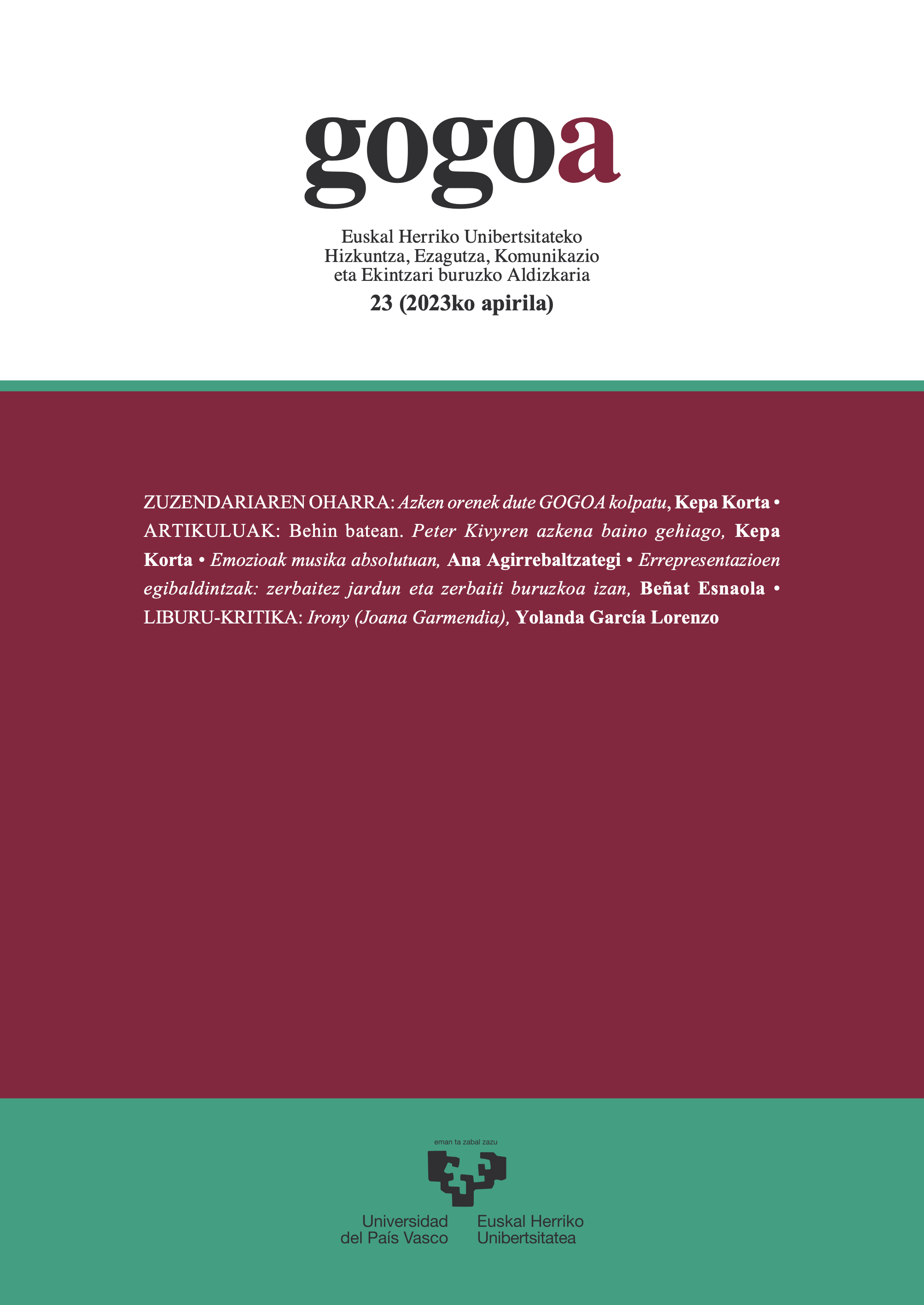References
Agirrebaltzategi, Ana. 2017. Emotions as Aesthetic Properties of Absolut Muic. Doktore-tesia, UPV/EHU.
Ben-Ze’ev, Aaron. 2000. The Subtlety of Emotions. Cambridge: MIT Press.
Budd, Malcolm. 1985. Music and the Emotions: The Philosophical Theories. Londres: Routledge.
Capwell, Charles. 1986. “South Asia”. In D. M. Randel (arg.), The New Harvard Dictionary of Music. Cambridge, MA: Belknap Press, 779. doi: 10.1017/S0140525X08005293
Collingwood, Robin G. 1938. The Principles of Art. Oxford: Clarendon Press.
Cooke, Deryck. 1959. The Language of Music. Oxford: Oxford University Press.
Darwin, Charles. 1889. Descent of Man, and Selection in Relation to Sex. Atondu eta osaturiko 2. argitalpena. New York: Appleton and Co.
Davies, Stephen. 1994. Musical Meaning and Expression. London: Cornell University Press.
Dewey, John. 1934. Art as Experience. New York: Putnam’s Sons.
Ekman, Paul. 1992. “An argument for basic emotions”. Cognition and Emotion 6 (3-4): 169-200. doi: 10.1080/02699939208411068
Elhuyar. 2011. Musika hiztegia. Vitoria-Gasteiz: Eusko Jaurlaritzaren Argitalpen zerbitzua.
Damasio, Antonio. 1994. Descartes’ Error. New York: Grosset-Putnam.
Fubini, Enrico. 1990. La Estética Musical desde la Antigüedad hasta el Siglo XX. Madril: Alianza Editorial.
Hanslick, Eduard. 1891. On the Musically Beautiful: A Contribution towards the Revision of the Aesthetics of Music. G. Payzanten itzulpena. Indianapolis: Hackett Publishing, 1986.
Huizi, Pello. 2018. “Emozio positiboak: alde argiak eta alde ilunak”. Gogoa 18: 131-154.
Izard, Carrol Ellis. 1977. The Emotions. New York, NY: Plenum Press.
Juslin, Peter. 2013. “What does music express? Basic emotions and beyond”. Frontiers in Psychology 4: 596. doi.org/10.3389/fpsyg.2013.00596
Kant, Immanuel. 1790. Critique of Judgement. J. C. Meredithen itzulpena. Oxford: Oxford University Press, 2008.
Kivy, Peter. 1989. Sound Sentiment: An Essay on the Musical Emotions. The Corded Shellen testua duela. Philadelphia, PA: Temple University Press.
Kivy, Peter. 1990. Music Alone: Philosophical Reflections on the Purely Musical Experience. Ithaca, N.Y.: Cornell University Press.
Kivy, Peter. 2001. “Sibley’s Last Paper”. In E. Brady eta J. Levinson, Aesthetic Concepts: Essays after Sibley. Oxford: Clarendon Press, 199-212.
Kivy, Peter. 2004. “Music, language and cognition: which doesn’t belong?”. In K. Korta eta J. M. Larrazabal (arg.), Truth, Rationality, Cognition, and Music. Dordrecht: Kluwer, 157-174. Hemen berrargitaratua: Peter Kivy, Music Language and Cognition: And Other Essays in the Aesthetics of Music. Oxford: Clarendon Press, 2007, 214-232.
Kivy, Peter. 2009. Antithetical Arts. On the Ancient Quarrel between Literature and Music. Oxford: Oxford University Press. ¬¬¬
Kivy, Peter. 2015. De Gustibus. Arguing About Taste, and Why We Do It. Oxford: Oxford University Press.
Korta, Kepa. 2016. “Peter Kivy: De Gustibus. Arguing about Taste and Why We Do It”. Gogoa 15: 43-66. DOI: 10.1387/gogoa.17257
Korta, Kepa. 2017. “The Meanings and Contents of Aesthetic Statements”. In R. Giora eta M. Haugh (arg.), Doing Pragmatics Interculturally: Cognitive, Philosophical and Sociopragmatic Perspectives on Language. Berlin, Boston: Mouton de Gruyter, 399-417. DOI:10.1515/9783110546095-022
Korta, Kepa. 2021. “Behin Batean: Peter Kivyren azkena baino gehiago”. Gogoa (aurrena online) https://doi.org/10.1387/gogoa.23252
Levinson, Jerrold. 1996. The Pleasures of Aesthetics. Ithaca, N.Y.: Cornell University Press.
Levinson, Jerrold. 2005. “Musical expressiveness as hearability-as-expression”. In M. Kieran (arg.), Contemporary Debates in Aesthetics and the Philosophy of Art. Oxford: Blackwell, 192-206.
Levitin, Daniel. 2006. This is your Brain on Music: The Science of a Human Obsession. N.Y.: Dutton Penguin Group.
Matravers, Derek. 2010. “Expression in the Arts”. In P. Goldie (arg.), The Oxford Handbook of Philosophy of Emotions. Oxford: Oxford University Press, 617-634.
Moravcsik, Julius. 1982. “Understanding and the emotions”. Dialectica 36: 11-12.
Oatley, Keith. ¬¬1992. Best Laid Schemes. Cambridge, MA: Harvard University Press.
Odifreddi, Piergiorgio. 2007. Pluma, pincel y batuta: las tres envidias del matemático. Madril: Alianza.
Peretz, Isabelle. 2010. “Towards a neurobiology of musical emotions”. In P. N. Juslin eta J. A. Sloboda (arg.), Music and Emotion. Oxford: Oxford University Press, 99-126.
Plutchik, Robert. 1994. The Psychology and Biology of Emotion. New York, NY: Harper-Collins.
Prinz, Jesse. 2004. Gut Reactions. N.Y.: Oxford University Press.
Power, Mick eta Tim Dalgleish. 1997. Cognition and Emotion. From Order to Disorder. Hove: Psychology Press.
Sibley, Frank. 1959. “Aesthetic Concepts”. In Philosophical Review 68 (4): 421-50. Hemen berrargitaratua: P. Lamarque eta S. H. Olsen (arg.), Aesthetics and the Philosophy of Art. The Analytic Tradition. Oxford: Blackwell, 2004, 127-141.
Stravinsky, Igor. 1972. Themes and Conclusions. Londres: Faber & Faber.
Tolstoy, Leo. 1898. What is Art? [Itzulpena: 1995. London: Penguin. Itzultzaileak: R. Pevear eta L. Volokhonsky].

